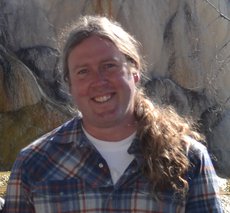Eric Boyd
Montana State University
Research Activities
The emergence of metalloenzymes capable of activating substrates such as CO, N2, and H2, were significant advancements in biochemical reactivity and in the evolution of complex life. Examples of such enzymes include [FeFe]- and [NiFe]-hydrogenase that function in H2 metabolism and Mo-, V-, and Fe-nitrogenases that function in N2 reduction. Many of these metalloenzymes have closely related paralogs that catalyze distinctly different chemistries, an example being nitrogenase and its closely related paralog protochlorophyllide reductase that functions in the biosynthesis of bacteriochlorophyll (photosynthesis). While the amino acid composition of these closely related paralogs are often similar, their biochemical reactivity and substrate specificity are often quite different. This phenomenon is a direct consequence of the composition and molecular structure of the active site metallocluster, which requires a number of accessory proteins to synthesize. By specifically focusing on the origin and subsequent evolution of these metallocluster biosynthesis proteins in relation to paralogous proteins that have left clear evidence in the geological record (photosynthesis and the rise of O2), we have been able to obtain significant insight into the origin and evolution of these functional processes, and to place these events in evolutionary time. In parallel to our evolutionary studies, we are examining the distribution and diversity of genes that encode for these proteins in environments with physical and chemical properties that are thought to be analogous to early Earth. Such environments include the geothermal springs in Yellowstone National Park, Wyoming and various saline environments in Utah and Northern Mexico. Using a number of computational approaches, we have been able to deduce the primary environmental parameters that constrain the distribution of these functional processes and which underpin their diversity. Such information is central to constraining the parameter space of environment types that are likely to have facilitated the emergence of these metal-based biocatalysts.
Selected Publications
Meuser, J.E., E.S Boyd, G. Ananyev, D. Karns, N.U.M. Murthy, R. Radakovits, , M.L. Ghirardi, J.W. Peters, and M.C. Posewitz. 2011. Evolutionary significance of an algal gene encoding an [FeFe]-hydrogenase with F-domain homology and hydrogenase activity in Chlorella variabilis NC64A. In press.
Hamilton, T.L., R.K. Lange, E.S. Boyd* and J.W. Peters. 2011. Biological nitrogen fixation in acidic high temperature geothermal springs in Yellowstone National Park, Wyoming. Environ. Microbiol. doi: 10.1111/j.1462-2920.2011.02475.x.
Hamilton, T.L., E.S. Boyd, and J.W. Peters. 2011. Environmental constraints underpin the distribution
and phylogenetic diversity of nifH in the Yellowstone geothermal complex. Microbiol. Ecol. doi: 10.1007/s00248-011-9824-9.
Boyd, E.S., A.D. Anbar, S.R. Miller, T.L. Hamilton, M. Lavin, and J.W. Peters. 2011. A late methanogen origin for the molybdenum-dependent nitrogenase. Geobiology. 9(3):221-232.
Shepard, E.M., E.S. Boyd, J.B. Broderick, and J.W. Peters. 2011. Biosynthesis of complex iron-sulfur enzymes. Curr Opin Chem Biol. 15(2):319-27.
Boyd, E.S., T.L. Hamilton, J.R. Spear, M. Lavin, and J.W. Peters. 2010. [FeFe]-hydrogenase in Yellowstone National Park: evidence of dispersal limitation and phylogenetic niche conservatism. ISME J. 4:1485–1495.
Barkay, T., K. Kritee, E.S. Boyd, and G.G. Geesey. 2010. A thermophilic bacterial origin and subsequent constraints by redox, light, and salinity on the evolution of the microbial mercuric reductase. Environ. Microbiol. 12(11):2904-2917.
Mulder, D.M., E.S. Boyd, R. Sarma, J.A. Endrizzi, R. Lange, J.B. Broderick and J.W. Peters. 2010. Structure of HydA?EFG, a key intermediate in [FeFe]-hydrogenase H-cluster biosynthesis. Nature. 465: 248-252.
Current Projects
- Hydrogeochemistry of Serpentinizing Systems — 2016 NAI
- Developing Methods for Life Detection on Mars and in Mars Analog Environments — 2016 NAI
- Project 1C: Analysis of Dissimilatory Iron-Reducing Microbial Communities in Chocolate Pots Hot Spring, Yellowstone National Park — 2015 NAI
- Physiology of Microbial Populations From W/R Hosted Ecosystems — 2015 NAI
- Rock Powered Life: Education and Communications — 2015 NAI
- Advances in Gene Sequencing From Low-Biomass Water-Rock Hosted Ecosystems — 2015 NAI
- High Temperature W/R Hosted Microbial Ecosystems in Yellowstone — 2015 NAI
- Subglacial Environments as Water‐Rock Hosted Microbial Ecosystems — 2015 NAI
- Project 1D: Comparative Genomic Analysis of Chemolithotrophic Fe(II)-Oxidizing Bacteria — 2015 NAI
- Stoichiometry of Life, Task 2a: Field Studies - Yellowstone National Park — 2014 NAI
- Project 1D: Iron Biogeochemistry in Chocolate Pots Hot Spring, Yellowstone National Park — 2014 NAI
- Project 1E: Microbial Communities in Chocolate Pots Hot Spring, Yellowstone National Park — 2014 NAI
- Project 1F: Chemolithotrophic Microbial Communities in Subglacial Sediments — 2014 NAI
- Task 3b: Ancient Records - Genomic — 2014 NAI
- Project 1D: Potential for Microbial Iron Reduction in Chocolate Pots Hot Springs, Yellowstone National Park — 2013 NAI
- Genetic Evolution and the Origin of Life — 2013 NAI
- Stoichiometry of Life, Task 2a: Field Studies - Yellowstone National Park — 2013 NAI
- Stoichiometry of Life, Task 3b: Ancient Records - Genomic — 2013 NAI
- Project 1E: Metagenomic Analysis of Novel Chemolithoautotrophic Bacterial Cultures — 2013 NAI
- Ecology of Extreme Environments: Characterization of Energy Flow, Bioenergetics, and Biodiversity in Early Earth Analog Ecosystems — 2012 NAI
- Molecular Evolution: A Top Down Approach to Examine the Origin of Key Biochemical Processes — 2012 NAI
- The Subglacial Biosphere – Insights Into Life-Sustaining Strategies in an Extraterrestrial Analog Environment — 2012 NAI
- Stoichiometry of Life, Task 3b: Ancient Records - Genomic — 2012 NAI
- Stromatolites in the Desert: Analogs to Other Worlds — 2012 NAI
- Stoichiometry of Life, Task 3b: Ancient Records - Genomic — 2011 NAI
- The Subglacial Biosphere – Insights Into Life-Sustaining Strategies in an Extraterrestrial Analog Environment — 2011 NAI
- Ecology of Extreme Environments: Characterization of Energy Flow, Bioenergetics, and Biodiversity in Early Earth Analog Ecosystems — 2011 NAI
- Molecular Evolution: A Top Down Approach to Examine the Origin of Key Biochemical Processes — 2011 NAI
- Paradigms for Complex Iron-Sulfur Cluster Assembly and the Origin and Evolution of Iron-Sulfur Enzymes — 2011 NAI
- Stromatolites in the Desert: Analogs to Other Worlds — 2011 NAI
- Molecular Paleontology of Iron-Sulfur Enzymes — 2010 NAI
- Radical SAM Enzyme Functional Diversity and Evolution — 2010 NAI
- Subglacial Methanogenesis and Implications for Planetary Carbon Cycling — 2010 NAI
- Stromatolites in the Desert: Analogs to Other Worlds — 2010 NAI
- Stoichiometry of Life, Task 3b: Ancient Records - Genomic — 2010 NAI
- Stoichiometry of Life - Task 1d - Experimental Studies - the Role of Molybdenum in the Nitrogen Cycle, Past and Present — 2010 NAI
- Stoichiometry of Life - Task 1f - Concept Studies - Nickel-Molybdenum Co-Limitation and Evolution of Mo-Nitrogenase — 2010 NAI
- Functional Based Habitability – Defining the Environmental Factors That Constrain Modes of Microbial Metabolism — 2010 NAI
- Stoichiometry of Life, Task 2a: Field Studies - Yellowstone National Park — 2009 NAI
- Stromatolites in the Desert: Analogs to Other Worlds — 2009 NAI
- Stoichiometry of Life, Task 2b: Field Studies - Cuatro Cienegas — 2009 NAI
- Evolution of Nitrogen Fixation, Photosynthesis, Hydrogen Metabolism, and Methanogenesis — 2009 NAI
- Stoichiometry of Life, Task 3b: Ancient Records - Genomic — 2009 NAI
- Subglacial Methanogenesis and Its Role in Planetary Carbon Cycling — 2009 NAI
- View all 44 projects
NAI Project Collaborators
- Project collaborators as reported by the latest NAI Annual Report.
-

Catherine Woodward
Institute for Biology Education - Mazomanie Outreach Outpost
Collaborated on 1 Project
Publications
-
Barkay, T., Kritee, K., Boyd, E., & Geesey, G. (2010). A thermophilic bacterial origin and subsequent constraints by redox, light and salinity on the evolution of the microbial mercuric reductase. Environmental Microbiology, 12(11), 2904–2917. doi:10.1111/j.1462-2920.2010.02260.x
See Project -
Boyd, E. S., Anbar, A. D., Miller, S., Hamilton, T. L., Lavin, M., & Peters, J. W. (2011). A late methanogen origin for molybdenum-dependent nitrogenase. Geobiology, 9(3), 221–232. doi:10.1111/j.1472-4669.2011.00278.x
See Project See Project See Project See Project See Project See Project -
Boyd, E. S., Fecteau, K. M., Havig, J. R., Shock, E. L., & Peters, J. W. (2012). Modeling the Habitat Range of Phototrophs in Yellowstone National Park: Toward the Development of a Comprehensive Fitness Landscape. Frontiers in Microbiology, 3. doi:10.3389/fmicb.2012.00221
See Project See Project -
Boyd, E. S., Hamilton, T. L., & Peters, J. W. (2011). An Alternative Path for the Evolution of Biological Nitrogen Fixation. Frontiers in Microbiology, 2. doi:10.3389/fmicb.2011.00205
See Project See Project See Project See Project -
Boyd, E. S., Hamilton, T. L., Spear, J. R., Lavin, M., & Peters, J. W. (2010). -hydrogenase in Yellowstone National Park: evidence for dispersal limitation and phylogenetic niche conservatism. ISME J, 4(12), 1485–1495. doi:10.1038/ismej.2010.76
See Project -
Boyd, E. S., Lange, R. K., Mitchell, A. C., Havig, J. R., Hamilton, T. L., Lafreniere, M. J., … Skidmore, M. (2011). Diversity, Abundance, and Potential Activity of Nitrifying and Nitrate-Reducing Microbial Assemblages in a Subglacial Ecosystem. Applied and Environmental Microbiology, 77(14), 4778–4787. doi:10.1128/aem.00376-11
See Project See Project See Project -
Boyd, E. S., Pearson, A., Pi, Y., Li, W-J., Zhang, Y. G., He, L., … Geesey, G. G. (2010). Temperature and pH controls on glycerol dibiphytanyl glycerol tetraether lipid composition in the hyperthermophilic crenarchaeon Acidilobus sulfurireducens. Extremophiles, 15(1), 59–65. doi:10.1007/s00792-010-0339-y
See Project -
Boyd, E. S., Skidmore, M., Mitchell, A. C., Bakermans, C., & Peters, J. W. (2010). Methanogenesis in subglacial sediments. Environmental Microbiology Reports, 2(5), 685–692. doi:10.1111/j.1758-2229.2010.00162.x
See Project -
Boyd, E. S., Spear, J. R., & Peters, J. W. (2009). [FeFe] Hydrogenase Genetic Diversity Provides Insight into Molecular Adaptation in a Saline Microbial Mat Community. Applied and Environmental Microbiology, 75(13), 4620–4623. doi:10.1128/aem.00582-09
See Project See Project -
Brown, I. I., Bryant, D. A., Casamatta, D., Thomas-Keprta, K. L., Sarkisova, S. A., Shen, G., … McKay, D. S. (2010). Polyphasic Characterization of a Thermotolerant Siderophilic Filamentous Cyanobacterium That Produces Intracellular Iron Deposits. Applied and Environmental Microbiology, 76(19), 6664–6672. doi:10.1128/aem.00662-10
See Project -
Driesener, R. C., Challand, M. R., McGlynn, S. E., Shepard, E. M., Boyd, E. S., Broderick, J. B., … Roach, P. L. (2010). -Hydrogenase Cyanide Ligands Derived From S-Adenosylmethionine-Dependent Cleavage of Tyrosine. Angewandte Chemie International Edition, 49(9), 1687–1690. doi:10.1002/anie.200907047
See Project See Project See Project -
Hamilton, T. L., Boyd, E. S., & Peters, J. W. (2011). Environmental Constraints Underpin the Distribution and Phylogenetic Diversity of nifH in the Yellowstone Geothermal Complex. Microbial Ecology, 61(4), 860–870. doi:10.1007/s00248-011-9824-9
See Project -
Hamilton, T. L., Lange, R. K., Boyd, E. S., & Peters, J. W. (2011). Biological nitrogen fixation in acidic high-temperature geothermal springs in Yellowstone National Park, Wyoming. Environmental Microbiology, 13(8), 2204–2215. doi:10.1111/j.1462-2920.2011.02475.x
See Project See Project See Project -
Hamilton, T. L., Vogl, K., Bryant, D. A., Boyd, E. S., & Peters, J. W. (2011). Environmental constraints defining the distribution, composition, and evolution of chlorophototrophs in thermal features of Yellowstone National Park. Geobiology, 10(3), 236–249. doi:10.1111/j.1472-4669.2011.00296.x
See Project See Project -
McGlynn, S. E., Boyd, E. S., Shepard, E. M., Lange, R. K., Gerlach, R., Broderick, J. B., & Peters, J. W. (2009). Identification and Characterization of a Novel Member of the Radical AdoMet Enzyme Superfamily and Implications for the Biosynthesis of the Hmd Hydrogenase Active Site Cofactor. Journal of Bacteriology, 192(2), 595–598. doi:10.1128/jb.01125-09
See Project See Project -
McGlynn, S. E., Boyd, E. S., Shepard, E. M., Lange, R. K., Gerlach, R., Broderick, J. B., & Peters, J. W. (2009). Identification and Characterization of a Novel Member of the Radical AdoMet Enzyme Superfamily and Implications for the Biosynthesis of the Hmd Hydrogenase Active Site Cofactor. Journal of Bacteriology, 192(2), 595–598. doi:10.1128/jb.01125-09
See Project See Project See Project See Project See Project -
Meuser, J. E., Boyd, E. S., Ananyev, G., Karns, D., Radakovits, R., Narayana Murthy, U. M., … Posewitz, M. C. (2011). Evolutionary significance of an algal gene encoding an [FeFe]-hydrogenase with F-domain homology and hydrogenase activity in Chlorella variabilis NC64A. Planta, 234(4), 829–843. doi:10.1007/s00425-011-1431-y
See Project -
Mulder, D. W., Boyd, E. S., Sarma, R., Lange, R. K., Endrizzi, J. A., Broderick, J. B., & Peters, J. W. (2010). Stepwise [FeFe]-hydrogenase H-cluster assembly revealed in the structure of HydAΔEFG. Nature, 465(7295), 248–251. doi:10.1038/nature08993
See Project See Project See Project See Project See Project See Project -
Peters, J. W., Boyd, E. S., D’Adamo, S., Mulder, D. W., Therien, J., & Posewitz, M. C. (2012). Hydrogenases, Nitrogenases, Anoxia, and H2 Production in Water-Oxidizing Phototrophs. Algae for Biofuels and Energy, None, 37–75. doi:10.1007/978-94-007-5479-9_3
See Project -
Schut, G. J., Boyd, E. S., Peters, J. W., & Adams, M. W. W. (2013). The modular respiratory complexes involved in hydrogen and sulfur metabolism by heterotrophic hyperthermophilic archaea and their evolutionary implications. FEMS Microbiol Rev, 37(2), 182–203. doi:10.1111/j.1574-6976.2012.00346.x
See Project -
Shepard, E. M., Boyd, E. S., Broderick, J. B., & Peters, J. W. (2011). Biosynthesis of complex iron–sulfur enzymes. Current Opinion in Chemical Biology, 15(2), 319–327. doi:10.1016/j.cbpa.2011.02.012
See Project See Project See Project See Project See Project See Project See Project -
Soboh, B., Boyd, E. S., Zhao, D., Peters, J. W., & Rubio, L. M. (2010). Substrate specificity and evolutionary implications of a NifDK enzyme carrying NifB-co at its active site. FEBS Letters, 584(8), 1487–1492. doi:10.1016/j.febslet.2010.02.064
See Project See Project See Project See Project See Project See Project -
Wang, Y., Boyd, E., Crane, S., Lu-Irving, P., Krabbenhoft, D., King, S., … Barkay, T. (2011). Environmental Conditions Constrain the Distribution and Diversity of Archaeal merA in Yellowstone National Park, Wyoming, U.S.A.. Microbial Ecology, 62(4), 739–752. doi:10.1007/s00248-011-9890-z
See Project -
Zadvornyy, O. A., Allen, M., Brumfield, S. K., Varpness, Z., Boyd, E. S., Zorin, N. A., … Peters, J. W. (2010). Hydrogen Enhances Nickel Tolerance in the Purple Sulfur Bacterium Thiocapsa roseopersicina. Environ. Sci. Technol., 44(2), 834–840. doi:10.1021/es901580n
See Project - Anbar, A.D., Boyd, E.S., Buick, R., Claire, M., Des Marais, D., Domagal-Goldman, S., Eigenbrode, J., Erwin, D., Freeman, K., Hazen, R., Johnson, C., Lyons, T., Meadows, V., Ohmoto, H., Ono, S., Peters, J.W., Shapiro, B., Summons, R. & Walter, M. (2010). An Archean biosphere initiative [abstract 5593]. Astrobiology Science Conference 2010. See Project
- Arslan, B., Boyd, E.S., Dolci, W., Dodson, E., Boldt, M. & Pilcher, C. (2011). Workshop without walls: Broadening access to science around the world. PLOS Biology, 9. doi:e1001118 See Project
- Arslan, B.K., Boyd, E.S., Dolci, W.W., Dodson, K.E., Boldt, M.S. & Pilcher, C.B. (2011). Workshop without Walls: Broadening access to science around the world. PLoS Biol, 8: e1001118. See Project
- Boyd, E.S. & Druschel, G.K. (In Review). The role of intermediate sulfur compounds in the reduction of elemental sulfur by Acidilobus sulfurireducens. See Project
- Boyd, E.S., Anbar, A.D., Miller, S., Hamilton, T.L., Lavin, M. & Peters, J.W. (Submitted). An early origin for Molybdenum-nitrogenase. Science. See Project
- Boyd, E.S., Pearson, A., Pi, Y., Li, W-J., Zhang, Y.G., He, L., Zhang, C.L. & Geesey, G.G. (2011). Physicochemical influences on glycerol dialkyl glycerol tetraether lipid composition in the crenarchaeote Acidilobus sulfurireducens. Extremophiles, 15(1): 59–65. See Project
- Glass, J.B., Boyd, E.S., Romaniello, S. & Anbar, A.D. (2010). Evolutionary metallomics: A nickel for nitrogenase. Nature Geoscience. See Project
- Glass, J.B., Boyd, E.S., Romaniello, S.J. & Anbar, A.D. (2010). Evolutionary metallomics: a nickel for nitrogenase. In review. See Project
- Hamilton, T.L., Boyd, E.S. & Peters, J.W. (2010). Geochemical controls on the phylogenetic structure and composition of NifH in Yellowstone National Park. In review. See Project
- Meuser, J.E., Boyd, E.S., Ananyev, G., Karns, D., Murthy, N.U.M., Radakovits, R., Dismukes, G.C., Ghirardi, M.L., Peters, J.W. & Posewitz, M.C. (2010). Presence of F-clusters in the Chlorella NC64A [FeFe]-hydrogenases provides new details into the evolution and diversity of algal hydrogen metabolism. Planta, Revision requested. See Project
- View all 34 publications

-
Phone:
406-994-7213 -
Fax:
406-994-5407 -
Email:
eboyd@montana.edu
Past NAI Teams
-
 VPL at University of Washington
VPL at University of Washington
CAN 4 -
 University of Colorado, Boulder
University of Colorado, Boulder
CAN 7 -
 University of Wisconsin
University of Wisconsin
CAN 6 -
 VPL at University of Washington
VPL at University of Washington
CAN 6 -
 Arizona State University
Arizona State University
CAN 5 -
 Montana State University
Montana State University
CAN 4

